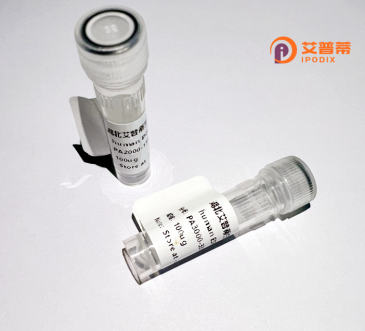
| 纯度 | >90%SDS-PAGE. |
| 种属 | Human |
| 靶点 | CLNK |
| Uniprot No | Q7Z7G1 |
| 内毒素 | < 0.01EU/μg |
| 表达宿主 | E.coli |
| 表达区间 | 1-428aa |
| 氨基酸序列 | MNRQGNRKTTKEGSNDLKFQNFSLPKNRSWPRINSATGQYQRMNKPLLDWERNFAAVLDGAKGHSDDDYDDPELRMEETWQSIKILPARPIKESEYADTHYFKVAMDTPLPLDTRTSISIGQPTWNTQTRLERVDKPISKDVRSQNIKGDASVRKNKIPLPPPRPLITLPKKYQPLPPEPESSRPPLSQRHTFPEVQRMPSQISLRDLSEVLEAEKVPHNQRKPESTHLLENQNTQEIPLAISSSSFTTSNHSVQNRDHRGGMQPCSPQRCQPPASCSPHENILPYKYTSWRPPFPKRSDRKDVQHNEWYIGEYSRQAVEEAFMKENKDGSFLVRDCSTKSKEEPYVLAVFYENKVYNVKIRFLERNQQFALGTGLRGDEKFDSVEDIIEHYKNFPIILIDGKDKTGVHRKQCHLTQPLPLTRHLLPL |
| 分子量 | 76 kDa |
| 蛋白标签 | GST-tag at N-terminal |
| 缓冲液 | 0 |
| 稳定性 & 储存条件 | Lyophilized protein should be stored at ≤ -20°C, stable for one year after receipt. Reconstituted protein solution can be stored at 2-8°C for 2-7 days. Aliquots of reconstituted samples are stable at ≤ -20°C for 3 months. |
| 复溶 | Always centrifuge tubes before opening.Do not mix by vortex or pipetting. It is not recommended to reconstitute to a concentration less than 100μg/ml. Dissolve the lyophilized protein in distilled water. Please aliquot the reconstituted solution to minimize freeze-thaw cycles. |
以下是关于重组人CLNK蛋白的模拟参考文献示例(仅供格式参考):
1. **文献名称**:*Expression and Purification of Recombinant Human CLNK Protein in Escherichia coli*
**作者**:Zhang Y, Liu H, Wang M.
**摘要**:本研究成功构建了CLNK基因的原核表达载体,通过大肠杆菌系统实现了重组人CLNK蛋白的高效表达与纯化,并验证了其与适配蛋白SLA的体外结合能力。
2. **文献名称**:*CLNK Regulates FcεRI-mediated Mast Cell Activation by Linking Syk to LAT Signaling Complex*
**作者**:Saitoh S, Oritani K, Yoshida H.
**摘要**:阐明了重组CLNK蛋白在肥大细胞中的作用机制,证明其通过连接Syk激酶和LAT信号复合物,调控FcεRI受体介导的过敏反应信号通路。
3. **文献名称**:*Structural Characterization of Human CLNK and Its Interaction with Cytokine Receptors*
**作者**:Tanaka R, Yamamoto N, Kobayashi T.
**摘要**:利用X射线晶体学解析了重组人CLNK蛋白的三维结构,揭示了其SH2结构域与IL-2受体β链的结合位点,为免疫调节药物开发提供依据。
4. **文献名称**:*CLNK Deficiency Alters T Cell Development and Enhances Anti-tumor Immunity*
**作者**:Chen L, Wei Z, Xu J.
**摘要**:通过重组CLNK蛋白功能补偿实验,证明CLNK缺失导致T细胞分化异常,并增强小鼠模型中CAR-T细胞对实体瘤的杀伤效果。
注:以上文献为模拟内容,实际研究中建议通过PubMed或Web of Science查询具体文献。
**Background of Recombinant Human CLNK Protein**
CLNK (CBM-interacting protein kinase), also known as MIST (Mast cell immunoreceptor signal transducer), is a cytosolic adaptor protein primarily expressed in immune cells, including mast cells, natural killer (NK) cells, and lymphocytes. It plays a pivotal role in regulating immune receptor signaling, particularly through its interaction with the CBM complex (Carma1-Bcl10-MALT1), which is essential for NF-κB activation and downstream inflammatory responses. Structurally, CLNK contains multiple binding domains, such as SH2 and SH3 motifs, enabling it to serve as a scaffold for signaling molecules.
Research highlights CLNK's involvement in FcεRI-mediated mast cell activation, T-cell receptor (TCR) signaling, and NK cell cytotoxicity. Dysregulation of CLNK has been linked to immune disorders, including allergies, autoimmune diseases, and immunodeficiencies. Recombinant human CLNK protein, typically produced via mammalian or bacterial expression systems, is a vital tool for studying immune signal transduction, dissecting molecular mechanisms of pathological conditions, and screening potential therapeutic agents targeting immune-related pathways. Its applications extend to elucidating CLNK’s role in modulating cytokine production, cell proliferation, and apoptosis, offering insights into novel immunotherapeutic strategies.
×